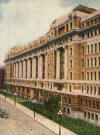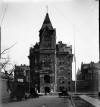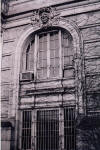























The Cook County Hospital
Please note...I did NOT take any of the pictures on this page..! I have a deep interest in old, somewhat decrepit buildings and the Cook County Hospital just so happens to fall into that category. If you took any of these pictures and would either like credit, or for me to remove the photograph in question, please email me.
The history of Chicago's hospitals begins with an almshouse established by Cook County as part of its responsibility to provide care for indigent or homeless county residents, and for sick or needy travelers. Located at the corner of Clark and Randolph streets, this public charity was in operation as early as 1835. It did provide medical attendance, but such places typically crowded the ill together with the healthy poor, the insane, and persons who were permanently incapacitated.
Located in Chicago and under control of the Commissioners of Cook County. It was originally erected by the City of Chicago, at a cost of 880,000, and was intended to be used as a hospital for patients suffering from infectious diseases. For several years the building was unoccupied, but, in 1858, it was leased by an association of physicians, who opened a hospital, with the further purpose of affording facilities for clinical instruction to the students of Rush Medical College.
In 1863 the building was taken by the General Government for military purposes, being used as an eye and ear hospital for returning soldiers. In 1865 it reverted to the City of Chicago, and, in 1866, was purchased by Cook County.
In 1874 the County Commissioners purchased a new and more spacious site at a cost of $145,000, and began the erection of buildings thereon. The two principal pavilions were completed and occupied before the close of 1875; the clinical amphitheater and connecting corridors were built in 1876-77, and an administrative building and two additional pavilions were added in 1882-84. Up to that date the total cost of the buildings had been $719,574, and later additions and improvements have swelled the outlay to more than $1,000,000.
It accommodates about 800 patients and constitutes a part of the county machinery for the care of the poor. A certain number of beds are placed under the care of homeopathic physicians.
The Cook County Hospital two-block-long
structure, dating to 1913-16, was designed by Paul Gerhardt and Richard Schmidt.
In addition to its impressive Beaux Arts-style façade, with three-story, fluted
Ionic columns, the building’s history includes numerous medical advancements,
including the first blood bank, indigent care, and modern emergency room
procedures. A quote from Pasteur is inscribed on the hospital's stone wall;
"One doesn't ask of one who
suffers: What is your country and what is your religion? One merely says, You
suffer. That is enough for me. You belong to me and I shall help you."
Once the nation's largest public
hospital and surrounded by poor neighborhoods, Cook County Hospital now stands
conspicuously in the middle of the 560-acre Illinois Medical District campus of
gleaming medical research laboratories, four hospitals, and two universities.
The 1910's-era Beaux-Arts-style landmark, designed by Paul Gerhardt and Richard
Schmidt, stands empty and motionless on Harrison Street, slowly recovering from
nearly 90 years of intense service but still seeming to call out for
rededication to its original purpose. Replaced by a mediocre (now awful) new
county hospital building in 2002, the old hospital visually embodies all of the
characteristics of public architecture that are so refreshing to an age in which
health care has drifted into commodity status and the design of public buildings
crudely mirrors the already-crude design of private buildings.
Despite years of protests, the effort to save one of the nation’s most historic hospital structures continues to be ignored. In Fall 2003, after promising to send a Request for Proposal to interested developers, Cook County officials instead invited bids to demolish the block-long Cook County Hospital, which had been vacant since early 2003. The demolition estimates range from $9.7 to $13.6 million, not including asbestos removal.